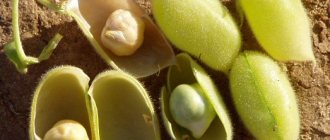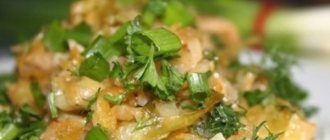Capers are the unopened buds of the caper plant. This plant is very useful and has been used for many, many years in many countries not only as a spice, but also as a medicine. Caperberry buds contain many vitamins and nutrients. They are often added to a wide variety of foods, they are not high in calories, and add piquancy and an unforgettable aroma to dishes. Of course, salted capers can be bought at any store, but can they compare with homemade capers? Of course not! So maybe we can try to cook them ourselves?!
- Cooking time: 8 hours or more
Cooking method
Sort the capers, rinse in a colander and let the water drain. Peel and rinse the garlic. Place on a cutting board and chop finely. Place in a plate. Peel the onion, wash it and, using a sharp knife, cut it into cubes up to 1 cm in size. Place it in a separate plate. Wash the lemon, dry and cut into pieces.
Pour apple cider vinegar into a saucepan, add onion, garlic and lemon slices. Add spices and salt. Place over moderate heat and heat the brine to a boil, stirring occasionally. Remove from heat and cool to room temperature.
Place the capers in clean jars so that the container is filled almost to the top. Pour brine up to the rim of the jar and close tightly with a sterilized lid. Place in the refrigerator for 2-6 weeks and you are ready to enjoy.
Salted capers are ready!
I noticed that from time to time I go to supermarkets not only for shopping, but also for excursions. Moreover, more and more often I find on the shelves things that I only heard or read about in childhood. Let's take, for example, the same capers. I won’t be mistaken if I say that at best, one in a hundred Russians will be able to say with confidence what kind of animal this is. And here they are, lying and looking at me. And I'm on them. I try not to look askance at the price tag. Scary.
So let's figure out what capers are, what they eat them with, and whether Russians have a real chance of trying them en masse.
Let's start by answering question one. The classic caper is nothing more than the flower bud of one southern thorn, which is called “Prickly caper”. Exactly the bud! Moreover, the length is no more than 10 millimeters. They will be collected from the bushes, sorted, dried in the hot southern sun - and put into jars. You can sprinkle it with salt, or add something like olive oil, brine or salted grape vinegar. The fruits of capers are also edible. And in some places, they say, shoots are also used, which, like the buds themselves, are usually used for food exclusively in salted or pickled form. Edible oil is extracted from the seeds, and a coloring matter is obtained from the roots.
What and how are they eaten with?
First, let's define the concepts. Capers are not simply eaten; they are a spice. They say it has an exceptionally specific taste. You can't confuse it with anything. In pickled and canned form, it is used to prepare sauces for fish, lamb and poultry, to add spiciness to soups and salads. You can prepare a vinaigrette sauce for fish. For it, beat 2 tablespoons of grainy mustard with 3 of the same tablespoons of olive oil, add black pepper and salt, capers, finely chopped shallots and fresh chopped parsley. This sauce is served with boiled fish and lettuce leaves. Delicious salsa with capers. Here we need finely chopped fresh tomatoes, capers, crushed garlic and fresh parsley. Serve salsa with fatty fish, such as sardines or herring. There is also a recipe for caper mayonnaise. For this, regular mayonnaise is mixed with mustard and finely chopped capers are added. This mayonnaise is very good with meat or poultry pates.
Capers are often used in combination with cheeses. They say, for example, that capers and cheese mashed with salt and black pepper are very tasty. You can cook the most ordinary pasta with capers. How? Everything is very simple. Take a couple of cloves of garlic, a little basil. Grind all this thoroughly and cut the tomatoes into slices. Stir well and place in a greased form. Sprinkle salt, a handful of bread crumbs and a tablespoon of oregano on top. While all this is baking in the oven, about thirty minutes, boil the pasta until half cooked. All that remains is to mix everything together, sprinkle with cheese - and again into the oven, but not for long, about five minutes. Sprinkle the finished dish with capers. You need about twenty grams of them.
This detail is also very important: capers cannot be subjected to heat treatment; they are added to already prepared dishes. How many? As they say, according to taste. There is no need to overdo it. However, this can be attributed to any other spice.
How to replace them
What if you want to try it, but can’t buy it, or there are no capers in the store? Believe it or not, a caper substitute grows near us. We are talking about the most common nasturtium. After all, it was previously grown as a vegetable plant, and among the alternative names there is this: “colored” or “cardinal” lettuce.
Again, we collect the buds and marinate them in vinegar. Fruits are also possible. Here's a caper substitute. Good nasturtium salad. Young leaves should be washed well and finely chopped on a plate so as not to lose the juice. Add a drop of lemon juice, dill, finely chopped sweet pepper, mix it all and sour cream. You can make Nasturtium Vinegar. We put 12 flowers in a dark glass bowl and pour a glass of table vinegar into it. After two to three weeks, the resulting liquid must be filtered and poured into another container. Salads and vinaigrettes with it are very tasty.
You can try making capers from dandelion flower buds. Pour half a kilogram of unopened baskets with hot marinade, bring to a boil and simmer over low heat for 5–10 minutes. They can be used as an additive to side dishes, meat and fish dishes.
Capers are a seasoning known all over the world that gives dishes a pleasant piquant taste. They are the unopened flower buds of a plant known as caperberry. Among hundreds of its species, the most commonly eaten plant is the prickly caperberry. If we talk about caper fruits, then these are sweet red berries with juicy pulp that tastes a little like watermelon.
The best varieties of capers compete with grapes in terms of profitability.
However, not every housewife knows how to use this product correctly. And in vain, because this spice can diversify many dishes. Below will be presented several original recipes using it. But let's start with the beneficial properties of this exotic product.
The named plant is cultivated in Western Europe, namely in Italy, Spain, the Balkan Peninsula, as well as in Africa and America. In addition, it is found in Crimea. By the way, pasta with capers is very popular in Italy.
Caperberry buds are famous for the presence of large amounts of vitamins C and P (rutin). The last vitamin is very useful for blood vessels. In particular, it strengthens the walls of blood vessels, prevents hemorrhages, and most importantly, it does not prevent sclerosis. White spots can often be seen on the surface of pickled capers - this is rutin, released under the influence of the marinade.
Capers also contain capparidin, a substance that has an antiallergic effect. And the various essential oils contained in this product have a positive effect on hair and skin. Note that caper seeds contain about 36% oil. Caperberry buds are rich in proteins, fiber and iodine. In addition, eating capers has a good effect on the female genitourinary system and even prevents cancer.
In folk medicine, buds and capers are used to heal wounds, internal bleeding and burns. They are also recommended for hypertension, jaundice, scabies, rheumatism and neuroses.
In turn, caper fruits are useful for diseases of the gums and teeth. In addition, it is worth noting that capers stimulate the appetite well and are recommended for use for cardiovascular diseases. But we must not forget about contraindications. So, it is better to forget about capers if you have hypotension and during pregnancy. There may also be individual intolerance.
Use of capers in medicine
Raw caperberry buds are used as an ingredient in medications for hypertension.
In addition, capers help heal wounds and burns, calm nerves, and strengthen the walls of blood vessels. Essential oils perfectly nourish hair and skin, and therefore can be used as components of therapeutic masks, and capparidin, which is part of the exotic product, has an anti-allergic effect.
It is believed that eating capers can prevent cancer, but this has not been scientifically proven. Therefore, it is better to pay attention to what capers are actually useful for: vitamins, microelements, ascorbic acid.
In addition to berries, the bark of the shrub is used in medicine, which has many useful qualities (antiseptic, analgesic, astringent).
The roots of the plant help with rheumatism and help reduce allergic manifestations. Decoctions in folk medicine were used for “nervous” diseases.
The leaves have bile and diuretic effects.
Note!
DIY garden decorations: 150 photos of original ideas and new products. Instructions with step-by-step guidance, diagrams and drawings
Fast-growing climbing plants for the fence and garden ☘️











